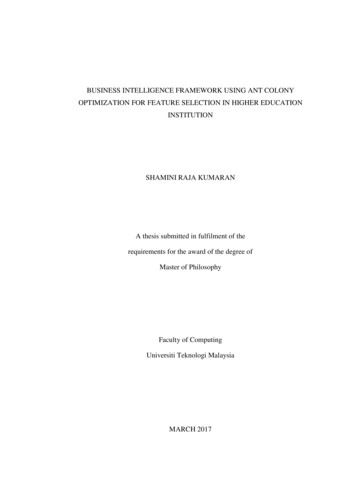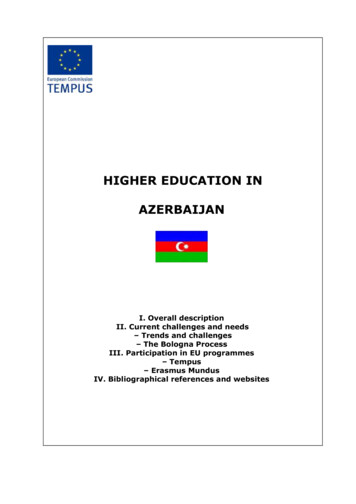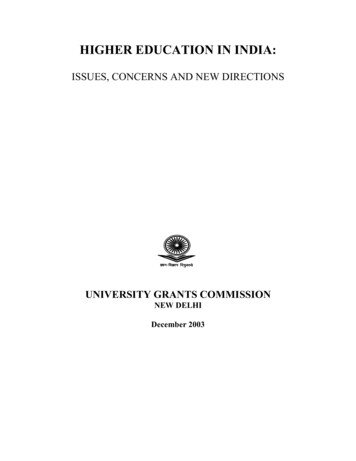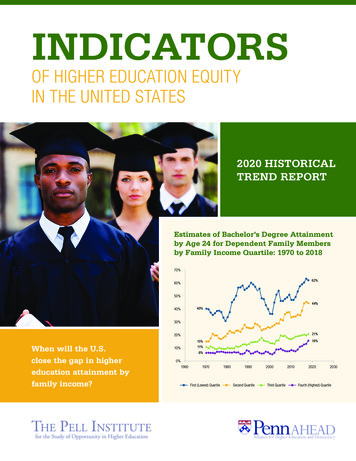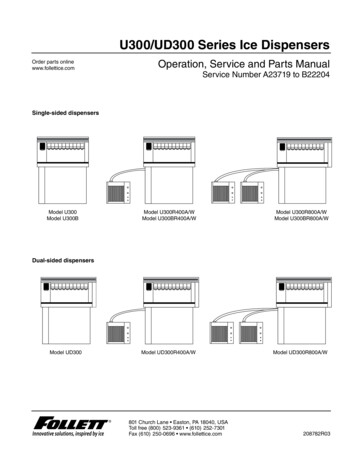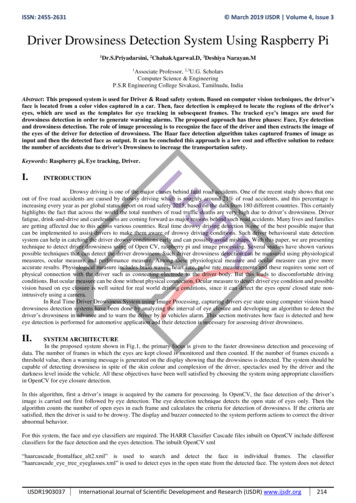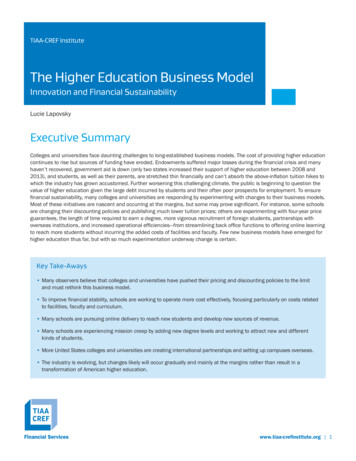
Transcription
TIAA-CREF InstituteThe Higher Education Business ModelInnovation and Financial SustainabilityLucie LapovskyExecutive SummaryColleges and universities face daunting challenges to long-established business models. The cost of providing higher educationcontinues to rise but sources of funding have eroded. Endowments suffered major losses during the financial crisis and manyhaven’t recovered, government aid is down (only two states increased their support of higher education between 2008 and2013), and students, as well as their parents, are stretched thin financially and can’t absorb the above-inflation tuition hikes towhich the industry has grown accustomed. Further worsening this challenging climate, the public is beginning to question thevalue of higher education given the large debt incurred by students and their often poor prospects for employment. To ensurefinancial sustainability, many colleges and universities are responding by experimenting with changes to their business models.Most of these initiatives are nascent and occurring at the margins, but some may prove significant. For instance, some schoolsare changing their discounting policies and publishing much lower tuition prices; others are experimenting with four-year priceguarantees, the length of time required to earn a degree, more vigorous recruitment of foreign students, partnerships withoverseas institutions, and increased operational efficiencies—from streamlining back office functions to offering online learningto reach more students without incurring the added costs of facilities and faculty. Few new business models have emerged forhigher education thus far, but with so much experimentation underway change is certain.Key Take-Aways Many observers believe that colleges and universities have pushed their pricing and discounting policies to the limitand must rethink this business model. To improve financial stability, schools are working to operate more cost effectively, focusing particularly on costs relatedto facilities, faculty and curriculum. Many schools are pursuing online delivery to reach new students and develop new sources of revenue. Many schools are experiencing mission creep by adding new degree levels and working to attract new and differentkinds of students. More United States colleges and universities are creating international partnerships and setting up campuses overseas. The industry is evolving, but changes likely will occur gradually and mainly at the margins rather than result in atransformation of American higher education.www.tiaa-crefinstitute.org 1
The sustainability of the United States higher educationbusiness model is the subject of much discussion today.Concerns relate to both the cost of operating colleges anduniversities, and the prices charged to students to supportat least a portion of those institutional costs. Many believethat the model is in need of fundamental change andare seriously concerned about the ongoing viability of theindustry. Indeed, Moody’s has placed a negative outlook onthe entire higher education industry.The bottom line is that colleges and universities facea daunting convergence of issues concerning access,affordability, and student outcomes. The cost of highereducation continues to rise while financial support fromstates and the federal government continues to decline,students and parents become more price sensitive, andmarket volatility hurts gift giving and endowments. What’smore, the value of a college degree is being questioned givenhigh levels of student debt and generally poor employmentprospects.This paper explores these issues and offers examples wherecolleges and universities are responding with operationalchanges to improve their business model and ensure theirfinancial sustainability, although most of these changes areoccurring at the margins. Beyond discussing a wide range ofinnovative responses to the challenges at hand, this paperalso presents a proposed agenda for future research.for-profits to alter their ways. The highly visible public scrutinyresulted in enrollment declines at several of the for-profitsand diminished enrollment growth at others—many of whichhad been growing at double digit rates.The public college sector almost uniformly experiencedsignificant reductions in state and local funding. Since FY2008, overall state funding for higher education has fallenby 28%. Only North Dakota and Wyoming increased theirsupport of higher education between 2008 and 2013. Statesupport for higher education began to pick up last year, withincreases in 30 states, but overall there was a small declinein state support from 2012 to 2013. Part of this decline isattributable to the recession, but a more worrisome factor isan attitude shift. Questions about the social compact relativeto government support for higher education are being askedmore frequently: What responsibility does government haveto support higher education? Is a public subsidy justified forthe public good portion of higher education (however thatcould be quantified)?HistoryReductions in state support have also affected privatecolleges in many states, but to a lesser extent than forpublic colleges. Additionally, the recession caused majorlosses to college endowments, which raised concerns aboutliquidity and the volatility of endowments—especially forthose wealthy institutions that are heavily dependent onendowment income to support their operating budgets. Manypublic and private colleges also experienced reductions ingift income.Higher education developed slowly in the United Statesfrom the founding of the nation’s first college, Harvard, in1636, to World War II. But after the GI bill opened college totens of thousands of returning veterans, higher educationhas been changing at an accelerating pace. By 1940, therewere about 1,000 schools and today there are more than4,400 regionally accredited colleges and universities, andmore than 10,000 other institutions of postsecondaryeducation—primarily vocational schools—in the United States.As one would expect, the number of students has also risendramatically, from 1.5 million students in 1940 to nearly 20million students today.A school’s business model and financial sustainability is alsolinked to its status. There are 30 to 50 elite institutions atthe top of the status ladder, a group comprised of the topresearch universities in the country, public and private, alongwith the highest ranked private liberal arts colleges. All ofthese institutions could fill their classes many times overfrom their existing applicant pool with high-ability, full-paystudents. For the most part, these elite institutions give onlyneed-based financial aid in order to diversify their classes interms of socio-economic status. They are also the wealthiestcolleges in the country with large endowments and wellknown brands.Higher Education Business Models TodayAt the other end of the status spectrum are open admissionschools, which accept anyone with a high school degreeor equivalency. This large group includes more than 1,600community colleges and many of the for-profit institutions.A third group is all of the other colleges and universitiesin the country, which includes more than 2,000 regionallyaccredited colleges and universities. Most schools in thisgroup have little brand recognition, are largely dependenton tuition, and are struggling to fill up their classes. Theprivate colleges in this group are aggressively discountingtheir tuition and working to articulate their value propositionto keep their campuses full. This third large group will haveColleges and universities, whether two- or four-yearinstitutions, are characterized in terms of ownership; thatis, whether they are public, private or for-profit institutions.There are significant differences in how institutions in eachof these categories are funded, and in the strains they havefelt during the last few years to their business models andfinancial sustainability. The for-profit colleges was the onlygroup thriving during the recession that began in 2008,until the federal government and accreditors began toquestion many of their recruiting and onboarding policies.This tarnished their reputation and motivated some of thewww.tiaa-crefinstitute.org 2
the most difficult time maintaining financial sustainability;indeed, many are already struggling. Closures and mergersamong this group are likely in the coming years.Mission Critical IssuesThe higher education industry is facing significant challenges,including demographic shifts, concerns about price and cost,and concerns about outcomes and new delivery methods.I will briefly discuss these challenges and then describeinnovations and strategies institutions are undertaking in aneffort to remain vital and viable.Access to EducationThe last decade has seen growth in both the number ofhigh school graduates and in their college-going rates.Demographic shifts in the next decade, however, areexpected to slow growth in the number of high schoolgraduates and will present significant challenges toincreasing the percentage of the population with degreesand high-quality credentials.Federal projections indicate that there will be a 1% increasein high school graduates in the next ten years, with a 2%increase from public high schools and a 7% decrease fromprivate high schools, yet the Federal government is projectinga 13% increase in undergraduate enrollment during thattime. This increased enrollment will be due to two factors:1) a significant increase in college-going rates of minorities,the fastest growing segment of our population; and 2) anincrease in adults going to college—some of whom hope tocomplete previous work toward a degree, and others who willjust be starting college at a later stage in their lives.Meanwhile, the pressure to move from “mass” highereducation to “universal” higher education is intense andhighly visible: In his 2013 State of the Union speech, President Obamacalled for the United States to be again first in the worldin college attainment by 2020. Lumina Foundation forEducation has set a national goal for 60 percent ofAmericans to have a high-quality degree or credentialby 2025. The Bill and Melinda Gates Foundation aims todouble the number of low-income adults who earn apostsecondary degree or credential with genuine valuein the marketplace by age 26.Today, 28% of the adult United States population hasa college degree. The United States ranks 12th amongdeveloped nations in the percentage of 25 to 34 year oldswith college degrees, and although the college-going rateof 18 to 24 year olds has increased from 25% in 1979 to41% today, this level is significantly below the goals set outabove. Further, college-going rates by race, ethnicity andsocioeconomic status reveal great inequities. The collegegoing rate of white students (44%) is significantly higher thanthe rates for black students (38%) and Hispanics (31%).If these trends continue, there will be an increasingly largenumber of undereducated youth in the United States. Figure1 shows the demographic changes occurring in the UnitedStates. Between 2010 and 2050, the highest growth rate inthe 0-24 year old population will all be among black, Latino,Asian and American Indians, with a projected 9% declineamong whites. (Source: U.S. Census Bureau)Figure 1: Changing demographics: 2010-2050Note: Projected Population Growth, Ages 0 to 24, 2010-2050Source: National Population Projections, U.S. Census Bureau.Released 2008; NCHEMS, Adding It Up, 2007College-going rate disparities are even greater whenevaluated by family income (see Table 1). Eighty-two percentof high school graduates from high-income families godirectly to college either full- or part-time, compared to 52%of low-income students. (Source: Education Pays 2013 - TheCollege Board)Table 1: Postsecondary Enrollment Rates ofRecent HS Graduates by Family le52%58%65%71%82%Source: Education Pays 2013 - The College Boardwww.tiaa-crefinstitute.org 3
AffordabilityHistorically, higher education is an industry with increasingcosts that requires more financial resources each year tosupport it. Unfortunately, the traditional sources of thatfunding have been under pressure since the recession.The primary source of support for higher education is stategovernments, but that has declined, sometimes significantly.Between 2008 and 2013 only two states, Wyoming andNorth Dakota, increased their support of higher education.The other states have decreased their support, ranging froma high of 50.4% in Arizona to a low of 3.2% in Alaska.Overall, the states have decreased their support by about30%. Meanwhile, gifting has declined since the recessionand the value of many endowments have suffered volatilityand steep declines.All these factors have put significant upward pressureon tuition--hurting affordability-- as schools have tried tocompensate for the lost funding. The trouble is, familiesare also hurting. Mean household income for all incomequintiles, and even for the top 5%, is the same or lowerthan it was in 2000. Yet tuition and fees have more thandoubled during this period, raising real concerns about theaffordability of higher education.An added wrinkle for families is that schools have takento significantly discounting their tuition, which has led touncertainty and confusion about the price of an institutionamong students and their families since the discountedprice is rarely known before the student is accepted. Table2 indicates that between 1990 and 2012, published instate tuition and fees increased 159% at public four-yearinstitutions, 97% at public two-year institutions, and 77%at private institutions. Yet when aid and tax breaks areaccounted for, the net price at community colleges hasactually decreased by a 1,000 while it has increased by58% at public four-year institutions and by 21% at privateinstitutions. The net price is less than half of the publishedprice in all three segments of higher education. The net pricediffers from the sticker price by all forms of grant aid that thestudent receives, as well as by the impact of tax deductionsand credits. Net price is not an easily conveyed figure,however, since it differs within institutions by student andisn’t determined until after the student is enrolled. Today,the average tuition discount solely from institutional aid forincoming freshmen at private colleges is 45% (NACUBO 2012Tuition Discounting Study).Table 2: Tuitions and Fees and Net Tuition and Fees: 1990-1991 to 2012-2013%Change 2012/1990Public Two-Year In-State90-9100-0110-1111-1212-13TuitionNet TuitionPublished Tuition and Fees 1,590 2,180 2,870 3,000 3,13097%-655%Net Tuition and Fees 220- 370- 1,460- 1,350- 1,220Public Four-Year In-State90-9100-0110-1111-1212-13Published Tuition and Fees 3,350 4,650 8,000 8,370 8,660159%58%Net Tuition and Fees 1,840 1,360 2,120 2,620 2,910Private Nonprofit Four-Year90-9100-0110-1111-1212-13Published Tuition and Fees 16,410 21,310 28,130 28,280 29,06077%21%Net Tuition and Fees 11,060 11,780 12,540 12,600 13,380Sources: The College Board, Annual Survey of Colleges, Trends in Student Aid 2012www.tiaa-crefinstitute.org 4
Even though net tuition has not increased nearly assignificantly as have published prices, grave concerns existthat the high price/high aid model is no longer sustainable.year colleges completed in six years, while 29.2% of studentsat two-year colleges completed in three years, according toNCHEMS.Affordability concerns are being fueled by growing publicattention to ever-increasing levels of student debt. Asshown in Table 3, the average debt per Bachelor’s degreerecipient at private colleges has increased from 23,400in 1999-2000 to 29,900 in 2010-11, an increase of 28%;the average debt for a student borrower attending a publiccollege has increased from 20,500 to 23,800 over thatsame time period, a 16% increase. In 2010-11, 43% ofpublic college students and 34% of private college studentsdid not borrow to fund their education.Legitimate questions are being raised as to why so fewstudents graduate, as well as why students are unable tograduate more quickly. True, there are shortcomings withthe data since the data measures only the graduation ratesof students who start as first-time, full-time students andwho graduate from the same institution at which they firstenroll. The data misses students who switch schools or taketime off. That said, graduation rates are too low; significantimprovement in completion rates would help highereducation make progress toward meeting national goals forcollege graduates and improving their own business model.Although students with exceptional debt of 100,000 ormore sometimes make headlines, average debt levels aremuch less than that and not unreasonable given the rateof return to higher education. The data show that collegegraduates earn 600,000 to 1.3 million more over thecourse of a lifetime than those with just a high schooldegree. Further, the unemployment rate of college educatedpeople during the last ten years (which includes the mostrecent recession), has consistently been significantly belowthat of less educated groups.Table 3: Average Total Debt Levels:1999-2000 to 2010-2011Per BorrowerPercentage whoborrowed1999- 2000 23,40063%2010 -2011 29,90066%28%5%1999- 2000 20,50054%2010 -2011 23,80057%16%6%Private Colleges% ChangePublic Colleges% ChangeSource: Trends in Student Aid, The College BoardSecond, serious concerns are being raised about whatstudents learn. Books such as Academically Adrift, writtenby Richard Arum and Josipa Roksa and published in2011, are harshly critical of the industry. Employers oftencomplain that people with college degrees do not meet theirexpectations. Institutions “certify” that their students meetgraduation requirements, but there are no national normsor minimum standards for college graduation. Except forthose fields which require licensing exams, there is littledata of a comparative nature on levels of student outcomes.Furthermore, the industry does a poor job tracking graduatesto see if they have found employment in their fields of study,or whether they have enrolled in graduate school. Whatdata exists is quite unreliable because the sample sizes areusually so small. As a result, the industry cannot quantifythe value of the education in statistically valid ways; collegestend to rely on anecdotal evidence to validate their value.Today, regional accrediting agencies are putting pressureon colleges and universities to assess student learningoutcomes, but most schools are struggling to find acceptableways to do so. The federal government has also beenpressuring colleges and universities to provide moreoutcomes data and may implement a measure based onwhat is called “gainful employment,” that is, quantitativedata about the jobs that students get after they graduate.Just what data might be required is still under discussion,but the prospect is causing considerable angst among highereducation leaders.Innovative ResponsesIn recent years, serious concerns have also been raisedabout the outcomes colleges and universities are producing.First, many students who begin college do not graduate,and many of those who do end up taking more than the“required” two years at community colleges or four years toearn a Bachelor’s degree. Graduation rates are commonlyquoted in terms of three- and six-year periods. The mostrecent data show that 55.5% of full-time students at four-Colleges and universities are working on a variety of fronts toremain competitive and financially sustainable. The financialimplications of these innovative responses for institutionalbusiness models, however, are not yet clear. And althoughthey often speak in terms of reinventing themselves, mostinstitutions in fact are working on the margins to makechanges in how they operate. Change is very difficult toimplement at many institutions; thus, what may look likewww.tiaa-crefinstitute.org 5
a relatively minor change to the outside world may beconsidered major to those within the institution. That said,several exciting and promising changes are occurring, asdescribed below.Pricing and DiscountingMany observers believe that colleges and universities havehit a wall in terms of their pricing and discounting policies.In response, several strategies are being pursued to reducethe price of college and provide consumers with moreinformation about the actual, net price that they will pay asopposed to the published sticker price.According to the latest NACUBO tuition discounting studyof four-year private colleges and universities, the averagediscount rate from institutional aid alone at these schoolsis 45% for first-time full-time students, and 40% for allundergraduates. Further, private institutions in this study,on average, provide institutional grants to 87% of theirfreshmen. The rate is in excess of 50% at more than 25%of the institutions participating in the study, which definesthe discount rate as the institutional financial aid awardeddivided by the gross tuition and fee collections. (Source:NACUBO 2012 Tuition Discounting Study)To provide consumers with additional information on thenet price that students will pay, the federal governmentnow requires that all schools include a net price calculatoron their website. Some schools with high discount rateshave decided that their high price/high aid strategy needsto be changed: they have lowered their published priceand decreased their discount rate, thus keeping net tuitionrevenue constant or even increasing it. The trend towardresetting tuition prices seems to be accelerating, with severalinstitutions recently announcing price reductions for fall2014.The rationale for a price decrease is that many students aredeterred from applying because of the high sticker price;the hope is that the price reset will increase the demand forthe institution. Some schools, both public and private, haveannounced price freezes and many have announced priceguarantees for four years. The for-profit University of Phoenixhas announced a price guarantee for between five and nineyears depending on the degree level sought. Beginning infall 2013, the University of Dayton is locking in its net pricefor four years. The rationale behind price guarantees is toprovide certainty to students and parents about the price ofcollege, although this does not necessarily provide certaintyabout the net price that they will pay.But there are other ways, besides tuition, to make educationmore affordable. The length of time it takes to completecollege affects the total cost to the student. Besides theout-of-pocket cost of tuition, the student is losing out onearnings. Thus, the more quickly a student can completecollege, the lower the total cost will be. Several schools nowguarantee that a student entering as a full-time freshman willgraduate within four years—or the additional time enrolledwill be paid for by the college as long as the student makesappropriate progress through school.Beyond the four-year guarantee, an increasing number ofschools are offering three-year bachelor degree programs.Many require only that three years of tuition be paid,while others charge tuition for additional summer terms.Manchester and Hartwick have recently begun three-yeardegree programs, and Southern New Hampshire Universityoffers a competency based (rather than seat-time based)three-year degree program. It also should be noted that theBologna Accord establishes a three-year degree as the normin Europe based on competencies, not seat time.Another innovation to lower costs is to encourage studentsto graduate from high school with college credits beyondthe Advanced Placement (AP) program. Two new initiativesaimed at getting high school students to graduate withcollege credit are gaining momentum: dual credit/dualenrollment and early college high school. Both programsoperate collaboratively between high schools and colleges.The most recent data from 2010–2011 show that 53% ofall colleges and universities had dual enrollment programsand the numbers have been steadily increasing, accordingto the Chronicle Almanac. Today, 98% of community collegesoffer high school students college credit. Community collegesare encouraging the growth of these programs, particularlyin states where their aid formulas have been changed to beperformance based. In performance based funding states,colleges receive at least some of their funds based onstudent outcomes, which usually include passing certainnumbers of college-level courses as one metric of success.The dual credit and early college high school students areusually quite successful since they are better prepared forcollege level work—unlike many of the regular students whobegin as new students at community colleges and requireremedial work. The cost to dual credit students for thecollege courses they take varies by jurisdiction, ranging fromthe student and his/her family paying the regular collegetuition rate, to paying a lower negotiated rate, to the highschool paying the college for the entire cost of the course.To encourage high school students to finish their Associate’sdegree at the community college where they have beentaking courses, some are offering scholarships. The rationaleis that these are proven students who are more likely tograduate than the general school population, and who willgenerate better outcomes for the school and, frequently,more state funding.www.tiaa-crefinstitute.org 6
A relatively new innovation to lower costs is to award creditbased on competency rather than seat time. Under thismodel, students can learn about specific subjects on theirown in any way they choose and then assemble a portfolioto show mastery of the subject, or take a test, or both.Schools that currently award credit for competency basedlearning include Western Governor’s University, SouthernNew Hampshire University, Wisconsin Extension Center,Westminster University, and Capella, among several others.MOOCs have burst on to the scene and have quickly becomeone way for students to gain subject mastery at little orno cost, and several schools have agreed to grant creditfor knowledge gained this way. The University of MarylandUniversity College (UMUC), beginning in fall 2013, grantscredit for six MOOCs that are similar to its introductoryofferings. To be awarded the credit, students will need toprove mastery of the material either by taking a paid versionof the course for 150 or less, which includes proctoredexams, or by going through a rigorous “prior learningassessment” process at UMUC, which measures competencyin the topic. Several other colleges and universities also haveplans to award credit for MOOCs.Another tactic schools are using to lower the cost forstudents is to make sure that students graduate with nomore credit hours than necessary. Articulation agreementsbetween community colleges and four-year institutions areencouraged so that students can transfer from two-year tofour-year institutions without losing credits. Unfortunately,this still doesn’t solve the problem; many schools acceptcredits but do not map the credits necessary to earn the fouryear degree. Thus students have to take excess credits toearn their Bachelor’s degrees despite the complete transferof the Associate’s degree credits.One strategy to cut down on excess course taking is toprovide immediate information to students when theyregister to let them know if they are registering for coursesthat do not count toward the credits they need for graduation.Additionally, many schools are working on streamlining thepathways to graduation by more clearly indicating what isrequired for each specific major. Furthermore, more schoolsare making advising mandatory so that students are offeredguidance and clearly understand how to progress fromfreshman year to graduation most efficiently. Finally, someschools are reevaluating the number of credit hours requiredto earn degrees for those programs that currently requiremore than 60 credit hours for an Associate’s degree or120 credit hours for a Bachelor’s degree. The University ofMaryland, for example, required all its departments to reviewtheir majors and seek board approval for any that requiredmore than 120 credit hours.The governors of Texas, Florida and Wisconsin arechallenging their public colleges and universities to usesome of these innovations to develop a 10,000 degree.For instance, in Texas the 10,000 degree is available forstudents with a 2.5 high school grade point average and atleast 30 college credits earned while in high school. Studentsbegin with a year at Southwest Junior College beforecompleting the degree at Sul Ross University Rio GrandeCollege. Students can earn the degree in several subjectsincluding biology, chemistry and mathematics.Increase Access and EnrollmentWhile schools are working to get students through collegemore efficiently, many are also working to broaden theirpool of prospective students to keep up demand for theeducation they provide. From a purely financial perspective,this is important so that schools have more potential toachieve the enrollment necessary to operate at capacity,as well as to diversify the sources of their tuition. Manyschools that historically focused on full-time traditional ageundergraduate students are marketing to adult students,including community college transfer students and veterans.Vassar College, for example, is “actively seeking to enrollqualified men and women who are veterans of the UnitedStates Armed Forces.” Many colleges are also increasingtheir recruitment of international students in order tobroaden their student pool. Today about 3% of all UnitedStates undergraduate enrollment is from foreign countries,but the proportion of foreign students varies widely amonginstitutions. The New School, with 27%
2008, overall state funding for higher education has fallen by 28%. Only North Dakota and Wyoming increased their support of higher education between 2008 and 2013. State support for higher education began to pick up last year, with increases in 30 states, but overall there was a small decline in state support from 2012 to 2013.



